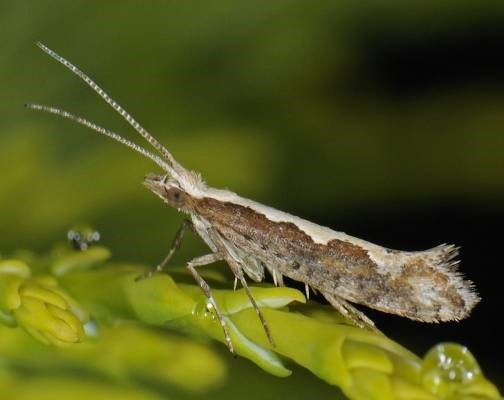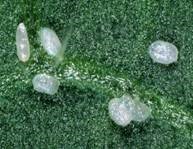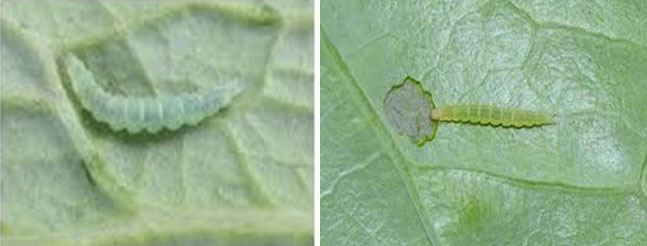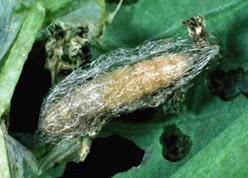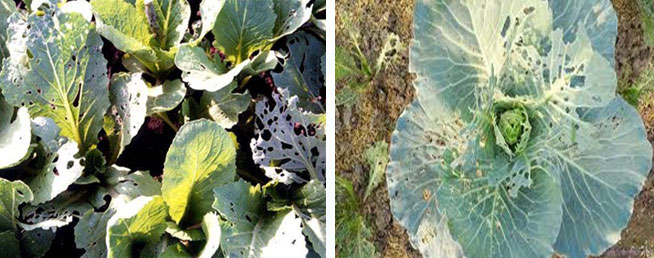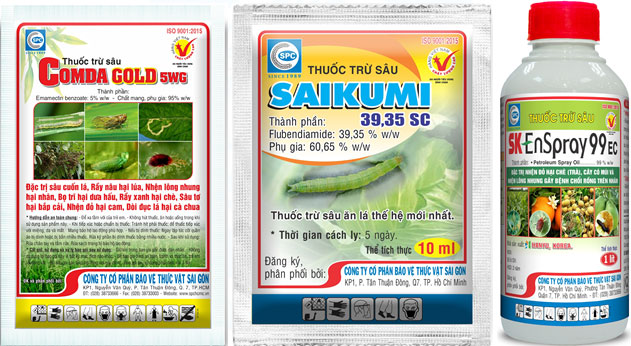|
Diamondback Moth Damaging Vegetables And Preventive Measures
30/08/2021
BSc Kim Xuan Loc Diamondback moth is a very dangerous worm that vegetable gardeners are very concerned about. Any vegetables, whether hard or soft stems, are damaged by diamondback moths (Plutella xylostella ). Especially vegetables such as kohlrabi, cabbage, leaf mustard, cauliflower, mustard greens, etc. are the vegetables most often damaged by diamondback moths The diamondback moth has the scientific name Plutella xylostella linnaeus, belonging to the family Plutellidae and the order Lepidoptera. MORPHOLOGICAL CHARACTERISTICS- BIOLOGY The diamondback moth has a length of 06 - 07 mm, a wingspan of 14 - 15 mm. The forewings are brown, with a wavy band in the middle of the back, white on male moths and yellow on female moths, extending to the end of the wings. The two edges of the hind wings have very long hairy fringes. When landing ,the wings are folded along the body and upright above the body, the wing tail is slightly raised. The antenna at the head are from 3 to 3.5 mm long and always facing the front very flexibly. Each female can lay 50-200 eggs. Flat and oval eggs,ivory white, 0.3 - 0.5 mm in diameter. Eggs are laid sporadically on the underside of leaves, near the main veins and hatch within 3 - 4 days.
The larvae are pale in color, the body is enlarged in the middle, the two ends are pointed, the body is divided into distinct segments. Larvae have 04 age levels, have a development time of about 11-15 days and if the temperature is low, it can be up to 18-20 days. The larvae are full of strength from 08 to 11 mm long and pupate right on the leaves of vegetables. When newly pupated, the pupa is light green, about 2 days later it turns to light yellow, has a length of 05 - 07 mm and is covered with silk threads. The development time of pupae range from 5 to 10 days depending on temperature conditions. After coming out of the cocoon for 2 - 3 days, the moth lays eggs. Moth mates and lays eggs in the evening, during the day and hides on the undersides of leaves or in hidden places in vegetable fields. HARMFUL CHARACTERISTICS: Newly-hatched larvae crawl up the leaf surface to gnaw the epidermis forming small zigzag grooves. Larvae from the age of 02 begin to eat leaves, leaving the cuticle forming translucent marks. Adults eat the entire leaf cuticle causing holes in leaves, reducing yield and quality of vegetables. When the density of worms is high, the damaged vegetable garden is shriveled, leaving only the leaf veins. Worms often release silk to drop to the ground when being touched by other objects, so it is also called "parachute worm". PREVENTIVE MEASURES - After harvesting, it is necessary to clean up the remnants of the tree, remove it from the field, destroy it or compost it as fertilizer to destroy eggs, larvae etc.. - Use natural enemies, use pheromone traps to effectively kill diamondback moths in adult - Rotating with crops that do not have the same host as rice, corn etc., should be intercropped with solanaceous plants such as eggplant, onion, garlic, etc. to scare away the adults from laying eggs. - Vegetables should be watered with a sprinkler in the cool ate afternoon to prevent from mating of adults and wash away eggs and larvae. - After a few crops of vegetables, a few other crops should be rotated. - Before pulling the plant out for planting, it is recommended to spray a wave of product on the nursery or dip the seedlings in an insecticide solution to destroy the existing pests, pupae and eggs on the seedlings. - Because diamondback moths do not usually fly high, it is possible to use a net of 02 m high can be used to surround them to prevent diamondback moths fly from the outside into the vegetable garden to lay eggs.
- Regularly check the fields, when seeing that the number of diamondback moths increases rapidly, it is necessary to spray insecticides in time. - diamondback moths are resistant to products very quickly, so to reduce the pressure of resistance of them, farmers can alternately use products such as Saikumi 39.35SC, Sec Saigon 25EC, Sapen Alpha 5EC, Comda Gold 5WG etc ..... - Because the diamondback moths are active in the evening, we can spray SK Enspray 99EC mineral oil at this time to scare away the moths or damage the eggs. |
To prevent, in addition to plowing and burying weed seeds, collecting weed stalks and stumps left after tilling the land to burn, not letting weeds produce seeds in production fields, etc., the use of chemical products is still a measure. optimal because of its ability to thoroughly kill weeds, reduce labor and take advantage of more time than manual weeding.
Miner has the scientific name Phyllocnistis citrella Staint., family Phyllocnistidae, order Lepidoptera. The miner occurs in many countries in the tropics and subtropics. The main host of the miner is the citrus family - Rutaceae. In addition, the miner also attacks mangosteen and some other plants.
Adult is a small planthopper, with a body 2-3 mm long, the whole body is ash gray, slightly greenish, the wings are opaque with many small brown spots.Eggs are oval, 0.3 mm long, have a pointed end and are attached directly to the leaf surface, leaf axils.
Green bugs specialize in the fruit of citrus groups (oranges, tangerines, lemons, grapefruits, kumquats...), some people call them orange bugs, or orange suckers. Their scientific name is Rhynchocoris poseidon or Rhynchocoris humeralis.
In Vietnam, yellow leaf curl disease is very common on papaya trees, especially the disease is often severe in areas of high and continuous planting, areas with hot and arid climates. The disease has significantly reduced the yield and quality of papaya. Gardens that are infected early when the plants are young may not yield. However, up to now, many gardeners still do not know the cause and how to fix it.
Spider mites are common pests on citrus trees, especially in hot and dry climates that are suitable for spiders to grow and cause severe damage.The group of harmful spiders is usually very small in size, unlike the natural enemy spiders.
This group includes species that are generally very small in size, causing damage by sucking plant sap (on leaves, fruits, branches, stems).
There are many species of mealybugs present on the group of Oranges,Tangerines,Grapefruits and Lemons (Citrus), which can be divided into 2 groups:
+ Group of sticky mealybugs with common varieties such as Lepidosaphes, Aonidiella, Coccus and Saissetia.
+ Group of flower mealybugs with common genera and species such as Pseudococcus, Planococcus and Icerya purchasi.
Dry branches and berries disease often appear to be common damage on coffee gardens during the rainy season. The disease causes death of branchs, dry fruit, severely affects the canopy structure and coffee yield if not paid attention to prevention.
Pink disease commonly causes diseases on rubber plantations in the rainy season, especially on garden from 4-8 years old. This year, rubber has to go through a period of severe drought, weakening the tree, so now in tnshe rainy season it is easy to get infected. Therefore, it is necessary to pay attention to good management to avoid affecting the garden.
In recent years, the area of citrus has been expanded because it is a fruit tree with high economic efficiency. However, in order to sell at a high price, not only in quality but consumers also require the external beauty of the fruit, so pest management on citrus is a matter of great concern to farmers. The hot season is a favorable condition for thrips to develop and cause damage, affecting the commercial value of fruit.
- Headquarters
- SAIGON PLANT PROTECTION JOINT STOCK COMPANY
- RQ 1, Nguyen Van Quy St., Tan Thuan Ward, HCM City
- Tax code: 0300632232
- Tel: (028) 38 733 295 - 38 732 077
- Fax: (028) 38 733 003 - 38 733 391
- Website: www.spchcmc.vn - Email: info@spchcmc.vn
- SAIGON PLANT PROTECTION COMPANY
- SAIGON PLANT PROTECTION JOINT STOCK ENTERPRISE
- Lot C1-C3 Hiep Phuoc Industrial Park, Hiep Phuoc Commune, HCM City
- Tel: (028) 3873 4089 - Fax: (028) 3873 4086
- Affiliated Unit
-
- Quick Links
- Home
- About us
- Career Opportunities


